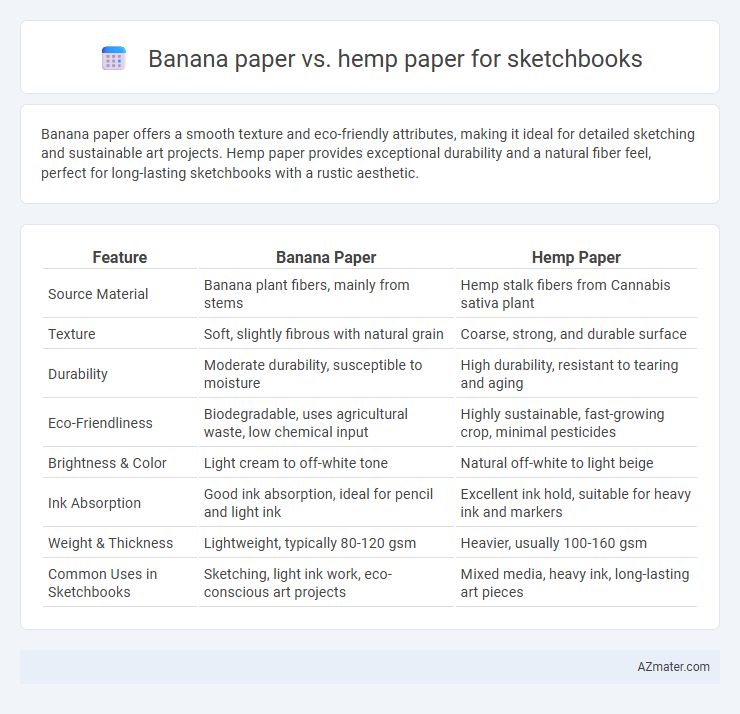Banana paper offers a smooth texture and eco-friendly attributes, making it ideal for detailed sketching and sustainable art projects. Hemp paper provides exceptional durability and a natural fiber feel, perfect for long-lasting sketchbooks with a rustic aesthetic.
Table of Comparison
| Feature | Banana Paper | Hemp Paper |
|---|---|---|
| Source Material | Banana plant fibers, mainly from stems | Hemp stalk fibers from Cannabis sativa plant |
| Texture | Soft, slightly fibrous with natural grain | Coarse, strong, and durable surface |
| Durability | Moderate durability, susceptible to moisture | High durability, resistant to tearing and aging |
| Eco-Friendliness | Biodegradable, uses agricultural waste, low chemical input | Highly sustainable, fast-growing crop, minimal pesticides |
| Brightness & Color | Light cream to off-white tone | Natural off-white to light beige |
| Ink Absorption | Good ink absorption, ideal for pencil and light ink | Excellent ink hold, suitable for heavy ink and markers |
| Weight & Thickness | Lightweight, typically 80-120 gsm | Heavier, usually 100-160 gsm |
| Common Uses in Sketchbooks | Sketching, light ink work, eco-conscious art projects | Mixed media, heavy ink, long-lasting art pieces |
Introduction to Banana Paper and Hemp Paper
Banana paper is crafted from the fibers of banana plants, offering a sustainable and eco-friendly alternative to traditional paper with a smooth texture ideal for sketching. Hemp paper, derived from hemp plant fibers, provides exceptional durability and a naturally coarse surface that enhances pencil and charcoal work. Both materials are increasingly popular in sketchbooks for artists seeking environmentally responsible options with unique tactile qualities.
Environmental Impact Comparison
Banana paper, made from banana plant fibers, utilizes agricultural waste, reducing deforestation and landfill waste, while hemp paper comes from fast-growing hemp plants that require less water and pesticides compared to traditional wood pulp. Hemp paper offers superior durability and biodegradability, absorbing less energy during production, making it a more sustainable option for environmentally-conscious artists. Both papers reduce reliance on wood-based pulp, but hemp's rapid growth cycle and lower environmental footprint in cultivation make it a preferred eco-friendly choice for sketchbook production.
Raw Material Sources and Sustainability
Banana paper is made from the fibers of banana plant pseudostems, a byproduct of banana harvesting that reduces agricultural waste and promotes circular economy practices. Hemp paper originates from the hemp plant stalks, known for rapid growth and requiring fewer pesticides, making it a highly sustainable raw material. Both raw materials offer eco-friendly alternatives to traditional wood pulp paper, with hemp providing superior durability and banana paper enhancing resource efficiency by utilizing waste fibers.
Paper Production Process Differences
Banana paper is produced by extracting fibers from banana plant bark through a mechanical and chemical pulping process, resulting in lightweight and textured sheets ideal for sketching. Hemp paper involves harvesting bast fibers from hemp stalks, which undergo retting, decortication, and refining to create durable, smooth surfaces preferred for detailed artwork. The rapidly renewable banana fibers offer an eco-friendly alternative with a distinct fibrous texture, while hemp's long fibers contribute to high strength and longevity in sketchbook paper.
Texture and Surface Quality for Sketching
Banana paper offers a smooth, slightly fibrous texture that enhances pencil and ink sketches with subtle variations in line quality. Hemp paper features a coarser surface, providing excellent tooth for charcoal and graphite, allowing for rich layering and shading effects. Both papers excel in durability, but banana paper's fine texture is ideal for detailed, precise work while hemp paper supports expressive, textured sketches.
Durability and Longevity in Artworks
Banana paper offers moderate durability with a fibrous texture that supports ink and pencil well but may yellow or weaken over time due to its natural composition. Hemp paper provides superior strength and longevity, resisting wear, moisture, and acid degradation, making it ideal for preserving artworks in sketchbooks long-term. Artists seeking archival quality and durability often prefer hemp paper for its resilience and ability to maintain artwork integrity over decades.
Ink and Media Compatibility
Banana paper offers a smooth surface that works well with ink, graphite, and light watercolor washes, but may absorb heavy media unevenly, causing slight bleed-through. Hemp paper boasts superior durability and a sturdy texture that resists ink feathering, making it ideal for pens, markers, and acrylics in sketchbooks. Both papers are eco-friendly choices, yet hemp paper's archival qualities better preserve ink vibrancy and prevent media deterioration over time.
Cost and Market Availability
Banana paper for sketchbooks generally costs more due to limited production and niche sourcing, while hemp paper offers a slightly lower price point backed by broader industrial cultivation. Hemp paper is more widely available in global markets because of established supply chains and growing eco-friendly demand, whereas banana paper remains a specialized product with constrained market presence. Cost efficiency and accessibility of hemp paper make it a preferred option for artists and manufacturers seeking sustainable sketchbook materials.
Artist Feedback and Preferences
Artists appreciate banana paper for its smooth texture and natural off-white tone, which enhances pencil and ink sketches with minimal bleed-through. Hemp paper is praised for its durability and eco-friendliness, providing a robust surface ideal for mixed media and heavy layering techniques. Feedback highlights banana paper's lightweight feel preferred by illustrators, while painters and printmakers often favor hemp paper's resilience and archival quality.
Conclusion: Which is Better for Sketchbooks?
Banana paper offers a unique texture and eco-friendly appeal with its natural fibers, promoting sustainability and biodegradability, while hemp paper provides superior durability, higher tensile strength, and better resistance to wear, making it ideal for heavy sketching and multiple media applications. For sketchbooks, hemp paper is generally better due to its ability to withstand erasing, layering, and use of wet and dry media without deterioration. The choice depends on whether eco-conscious texture or long-lasting performance is the primary priority for the artist.

Infographic: Banana paper vs Hemp paper for Sketchbook
 azmater.com
azmater.com